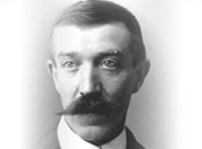|
Olly
Whateley |
Aston
Villa FC
2 appearances,
2 goals on debut
P 2 W 1 D
0 L 1 F 9: A 3
50% successful
1883
captain: none
minutes played: 180 |
 |
|
Timeline |
|
|
Oliver Whateley |
|
Birth |
Friday, 8 August 1862 in St. George's Park, Birmingham, Warwickshire |
|
|
registered as Whatley in Birmingham October-December 1862 |
|
|
|
According to the
1871 census, eight year-old Oliver is the youngest of seven children to
James Thomas and Mary (née Rogers), living at 355 Farm Street in the Hampton area of
Birmingham. His father is a pearl button maker. |
|
|
According to the 1881
census, Oliver is the youngest of the four children still living at home
with their parents at 355 Farm Street. He is a lithographer, while his
father is a button manufacturer employing twelve. |
|
Marriage |
to Mary Hands, in early-1888 in
Birmingham. |
|
|
registered in Birmingham April-June 1888 |
|
|
According to the
1891 census, Oliver is married to Mary and is a designer for lithography.
They live at 23 Alderville Road in Fulham.
(His mother died on 26
January 1893 at 9 Lozzells Street, Aston and his father died 18 November
1893 at 186 Villa Street, Aston)
The 1893 London
Electoral Register puts Whateley at 1 Ewald Road in Fulham.
The 1895-99
Surrey Electoral Register's places Whateley at Elm Lodge in Mortlake. |
|
|
According to the 1901
census, Oliver and his wife are lodging at 40 Petteril Street in the
Rickergate area of Carlisle. He is a lithographic artist. They are lodging
with the Friar family.
Various London Electoral Registers places Whateley in various London
addresses. From at least 1908 until 1910, he is at 20 Charlwood Road in
Putney. |
|
|
According to the 1911
census, Oliver and Mary remain married and they live at Flat 3, 65
High Street, back in Fulham, London. Oliver is a printer's artist.
From 1911 until at least 1914, they were at 65 High Street in Fulham. In 1918, Oliver and Mary
are in the flat over the stable at 16 Kingswood Road in Camberwell. |
|
|
Neither Oliver or Mary can be
found on the 1921
census. |
|
Death |
Thursday, 28 October 1926 in Birmingham,
Warwickshire |
|
aged 64 years 81 days |
registered in Birmingham North October-December 1926 |
|
Obituary |
|
"Olly Whateley. the old Aston
Villa forward, whose death is announced, was with the famous club in the
'eighties, and in his day he was deemed by many as the greatest shot ever
known. Whateley joined the Villa in 1800, and played inside right to Andy
Hunter, with Archie Hunter as centre forward. He played for England v.
Scotland and Ireland in 1882-83. Despite his age he served in the war in
command of the Y.M.C.A. hut at Rouen for four years. Whateley by trade was
an artist and designer." - Birmingham Daily Gazette, Friday, 29 October 1926. |
|
Funeral |
Saturday, 30 October 1926 at Witton Cemetery, Moor Lane, Birmingham |
|
|
Mary Whateley died in early 1939 |
|
Source |
Douglas Lammings' An
English Football Internationalist Who's Who [1990] &
 |
|
Playing Career |
|
Club(s) |
Began with Gladstone Unity FC. He then moved to Aston Villa FC
from July 1880 to May 1888. |
|
Club honours |
FA Cup winners 1886-87 (did not play); |
|
Individual honours |
None |
|
Height/Weight |
not known |
|
Source |
Douglas Lammings' An English
Football Internationalist Who's Who [1990]. |
|
England Career |
|
Player number |
One of
six who became the 103rd players (108) to appear
for England. |
|
Position(s) |
Inside-left, outside-right |
|
First match |
No.
18, 24 February 1883, England 7 Ireland 0, a friendly match at
Liverpool Cricket Ground,
Aigburth Road, Aigburth,
Liverpool, aged 20 years 200 days.
  |
Last match
14 days |
No. 19, 10 March 1883, England 2
Scotland 3, a friendly match at Yorkshire County Cricket Ground, Bramall Lane, Highfield, Sheffield, aged
20 years 214 days. |
|
Individual honours |
The North (one appearance, January 1885) |
|
Beyond England |
|
Retired from football
with cancer of the face! By vocation an artist,
designer and draughtsman, and in 1911 underwent a severe operation.
Nonetheless, although too old for military service, he served in Rouen,
France, with the YMCA during the First World War. In the twenties, in
poor health, he fell on hard times, and so strained were his circumstances
that, in 1923, Aston Villa set up a fund to help him.
-
An English Football Internationalists' Who's Who.
Douglas Lamming (1990). Hatton Press, p.265/6. |